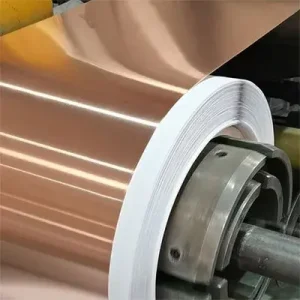
Copper Foil For Transformer Windings

What is a Copper Strip?
Copper strip is a common electrical material. There are two common types of copper strip, called conductive and non-conductive. A conductive copper strip conducts electricity on the top and bottom of the tape, while a non-conductive copper strip conducts electricity only on one side. LP Industry mainly provides Copper foils for transformer winding, which is also called transformer copper super thin strips, are mainly used in the transformers manufacturing industries.
The commonly used copper grades are ETP Grade (Electrolytic Tough Pitch), C11000, UNS C10200 TU1, temper O state.
The thickness of copper foil is usually between 0.01mm-3.0mm.
The transformer winding copper foil can be customized according to customer requirements of different widths and thicknesses.
Main specifications
| Conductor | Copper Strip/Foil |
| Grade | Cu-ETP/C-11000/E-Cu588 |
| Temper | Soft(O); Hard(H) |
| Dimension | Thickness 0.1-4.0mmWidth 20-1500mm |
| Cu (Min) | 99.99%, 99.99% |
| Standard | ASTM,EN 13599,GB-T 18813-2002 |
| Packing | In coil, inner diameter,300m,400mm,500mm etc. |
| Application | Winding of transformers, large scale motors, generator and stators etc. |
Smaple Test
In order to ensure the quality of copper strips before leaving the factory, samples will be taken for testing, either according to standards or according to customer requirements.
| Item | Condition of supply | Size(mm) | Temper | Weight | Batch No., | |||
| Copper foil | C11000 | 0.5×300 | soft | 1968.50KGS | T008-2663 | |||
| Chemical Composition (%) | ||||||||
| Item | Cu | P | Bi | Sb | As | Fe | Pb | S |
| Standard requested | >99.95 | <0.001 | <0.001 | <0.002 | <0.002 | <0.005 | <0.005 | <0.005 |
| Testing result | 99.9923 | 0.00075 | 0.00033 | 0.0001 | 0.00071 | 0.0029 | 0.00066 | 0.0017 |
| Mechanical Properties | ||||||||
| Item | Vickers Hardness | ensile strength(Mpa | Conductivity(%IACS) | Elongation%(A50) | – | |||
| Standard requested | 45-65 | 195~260 | ≥98 | ≥35 | – | |||
| Testing result | 57.5 | 242 | 100 | 48 | – | |||
| DescriptionUpon products arriving, please dismount to Check at once and store in Dry place indoor. | ||||||||
How does Copper foil for transformer winding work?
Working Principle
Electromagnetic Induction:
Just like traditional wire windings, copper foil windings work on the principle of electromagnetic induction. When an alternating current (AC) passes through the primary winding, it generates a magnetic field, which induces a voltage in the secondary winding.
Winding Process:
Uniform Distribution: Copper foil can be wound tightly and uniformly around the transformer’s core. This uniformity helps in maintaining consistent electrical characteristics across the winding.
Layering: Multiple layers of foil can be wound with insulation between each layer to achieve the desired voltage and current characteristics.
Advantages
Copper foils are commonly used in transformer windings, especially for high-frequency transformers and certain types of power transformers.
Optimize foil thickness
Minimize number of layers
Use multiple parallel foils and swap layers
Use different foil thicknesses for different turns.
Use a parallel litz or thin foil winding in the vicinity of a gap
Interleave winding (transformers only)
Use a low permeability material for core leg
